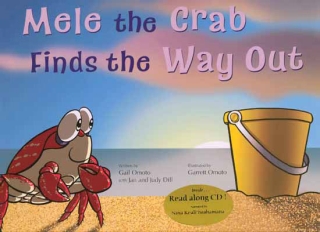Gone are the days of the alamihi ways
-Israel Kamakawiwo’ole, E Ala E

IZ could not better summarize the most idealistic outcome for Mele the Crab Finds the Way Out, (Partners in Development Foundation, 2007) a children’s picture book which uses the metaphor of ‘alamihi crab syndrome (or “crab mentality”) to illustrate a simple, Biblical lesson.
Recommended to us by Kalihi-Palama librarian Marcia Nakama (read our write-up here), Mele the Crab Finds the Way Out is written by Gail Omoto with Jan and Judy Dill and illustrated by Garrett Omoto; the same people who brought you Kai the ‘Opihi Gets the Point (reviewed by us here). While not quite as sharp as the previous title (haha), Mele the Crab provides children a simple, straightforward rhyming tale to get its point across.
Mele is a crab, gifted with the benefit of superior genetics and extreme ability; she can conquer the rock mountain better than any other crab. Mele does so, however, at the expense of others, climbing over and using crabs as stepping stones on her way to the top. Despite her inherent talents, one unfortunate day she is snagged in a trap and imprisoned inside a bucket along with a few other unlucky crabs, inevitably bringing us to the primary conflict and climax of the story.
Through the struggle between Mele and the other crabs trapped in the bucket, Mele the Crab fully illustrates the metaphor of crab mentality. What this is, is when one crab attempts to escape the bucket by climbing over the side, other crabs will pull him back down, thus creating a futile situation for all parties involved because they refuse to see one crab from their unfortunate lot climb to success. In Hawaii, this is often known as ‘alamihi crab syndrome. There is a great letter written by Kekailoa Perry that explains in detail the problem with the myth of the ‘alamihi crab syndrome and how it relates to Native Hawaiian issues.2
Although this book may work on those higher levels of social issues, there really is a simple message involved that is conveyed by the authors:
…If anyone wants to be first, he must be the very last, and the servant of all.
-Mark 9:35b
It’s a profound message of humility and cooperation; putting others before yourself to the benefit of everyone including yourself. I also appreciate that the moral Mele follows is one she learned from her grandmother. It provides children with an example of respect for the elderly, as well as the importance of passing down knowledge from generation to generation.
As for the illustrations, they loom large and are often well framed on the page. In fact, I found some of the angles employed by Garrett Omoto to be quite brilliant. I occassionally felt, however, that some of the art appeared a little too Photoshopped, especially as it related to certain fill-effects and radial bursts. There’s something to be said for the personal touch of a sure hand. As a result of this computer-graphic look, there were times I felt the scenery was slightly alienated from the rather cute illustrations.
Overall a solid effort that can work on multiple levels. The story is fun and imaginative (based on the real life experiences of crabbing, and the ) and has the generally important Christian moral of the virtues of self sacrifice. Although, if you love eating crab you may find yourself with a tear in your eye seeing the little buggers get away. 🙂
Mele the Crab Finds the Way Out
Written by Gail Omoto and Jan and Judy Dill
Illustrated by Garrett Omoto
Partners in Development Foundation, 2007




